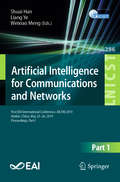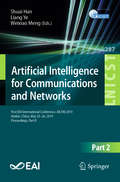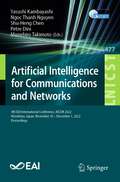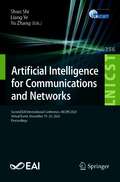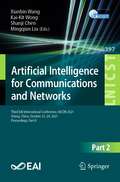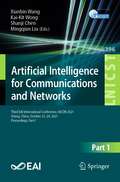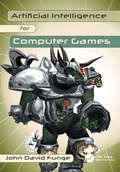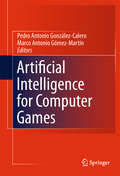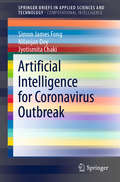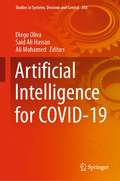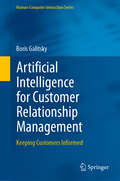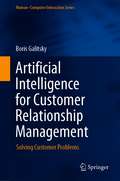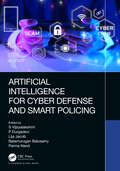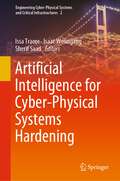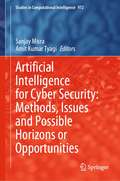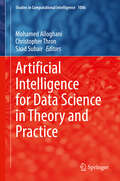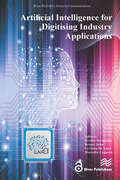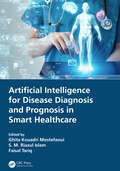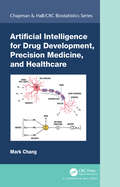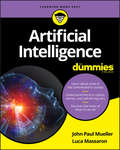- Table View
- List View
Artificial Intelligence for Communications and Networks: First EAI International Conference, AICON 2019, Harbin, China, May 25–26, 2019, Proceedings, Part I (Lecture Notes of the Institute for Computer Sciences, Social Informatics and Telecommunications Engineering #286)
by Shuai Han Liang Ye Weixiao MengThis two-volume set LNICST 286-287 constitutes the post-conference proceedings of the First EAI International Conference on Artificial Intelligence for Communications and Networks, AICON 2019, held in Harbin, China, in May 2019. The 93 full papers were carefully reviewed and selected from 152 submissions. The papers are organized in topical sections on artificial intelligence, mobile network, deep learning, machine learning, wireless communication, cognitive radio, internet of things, big data, communication system, pattern recognition, channel model, beamforming, signal processing, 5G, mobile management, resource management, wireless position.
Artificial Intelligence for Communications and Networks: First EAI International Conference, AICON 2019, Harbin, China, May 25–26, 2019, Proceedings, Part II (Lecture Notes of the Institute for Computer Sciences, Social Informatics and Telecommunications Engineering #287)
by Shuai Han Liang Ye Weixiao MengThis two-volume set LNICST 286-287 constitutes the post-conference proceedings of the First EAI International Conference on Artificial Intelligence for Communications and Networks, AICON 2019, held in Harbin, China, in May 2019. The 93 full papers were carefully reviewed and selected from 152 submissions. The papers are organized in topical sections on artificial intelligence, mobile network, deep learning, machine learning, wireless communication, cognitive radio, internet of things, big data, communication system, pattern recognition, channel model, beamforming, signal processing, 5G, mobile management, resource management, wireless position.
Artificial Intelligence for Communications and Networks: 4th EAI International Conference, AICON 2022, Hiroshima, Japan, November 30 - December 1, 2022, Proceedings (Lecture Notes of the Institute for Computer Sciences, Social Informatics and Telecommunications Engineering #477)
by Yasushi Kambayashi Ngoc Thanh Nguyen Shu-Heng Chen Petre Dini Munehiro TakimotoThis book, AICON 2022, constitutes the post-conference proceedings of the 4th EAI International Conference on Artificial Intelligence for Communications and Networks, AICON 2022, held in Hiroshima, Japan, in November 30- December 1, 2022. The 9 full papers and 4 short papers were carefully reviewed and selected from 36 submissions. The papers detail research in the areas of AI and communication systems related to intelligent systems and computational intelligence for communication and networks. They are organized in topical sections on AI and networks; machine learning; and evolutionary computation.
Artificial Intelligence for Communications and Networks: Second EAI International Conference, AICON 2020, Virtual Event, December 19-20, 2020, Proceedings (Lecture Notes of the Institute for Computer Sciences, Social Informatics and Telecommunications Engineering #356)
by Shuo Shi Liang Ye Yu ZhangThis book constitutes the post-conference proceedings of the Second EAI International Conference on Artificial Intelligence for Communications and Networks, AICON 2020, held in December 2020. Due to COVID-19 pandemic the conference was held virtually.The 52 full papers were carefully reviewed and selected from 112 submissions. The papers are organized in topical sections on Deep Learning/Machine Learning on Information and Signal Processing; AI in Ubiquitous Mobile Wireless Communications; AI in UAV-assisted wireless communications; Smart Education: Educational Change in the age of artificial Intelligence; AI in SAR/ISAR Target Detection; Recent advances in AI and their applications in future electronic and information field.
Artificial Intelligence for Communications and Networks: Third EAI International Conference, AICON 2021, Xining, China, October 23–24, 2021, Proceedings, Part II (Lecture Notes of the Institute for Computer Sciences, Social Informatics and Telecommunications Engineering #397)
by Xianbin Wang Kai-Kit Wong Shanji Chen Mingqian LiuThis two-volume set LNICST 396 and 397 constitutes the post-conference proceedings of the Third EAI International Conference on Artificial Intelligence for Communications and Networks, AICON 2021, held in September 2021. Due to COVID-19 pandemic the conference was held virtually. The 79 full papers were carefully reviewed and selected from 159 submissions. The papers are organized in topical sections on Artificial Intelligence in Wireless Communications and Satellite Communications; Artificial Intelligence in Electromagnetic Signal Processing; Artificial Intelligence Application in Wireless Caching and Computing; Artificial Intelligence Application in Computer Network.
Artificial Intelligence for Communications and Networks: Third EAI International Conference, AICON 2021, Xining, China, October 23–24, 2021, Proceedings, Part I (Lecture Notes of the Institute for Computer Sciences, Social Informatics and Telecommunications Engineering #396)
by Xianbin Wang Kai-Kit Wong Shanji Chen Mingqian LiuThis two-volume set LNICST 396 and 397 constitutes the post-conference proceedings of the Third EAI International Conference on Artificial Intelligence for Communications and Networks, AICON 2021, held in September 2021. Due to COVID-19 pandemic the conference was held virtually. The 79 full papers were carefully reviewed and selected from 159 submissions. The papers are organized in topical sections on Artificial Intelligence in Wireless Communications and Satellite Communications; Artificial Intelligence in Electromagnetic Signal Processing; Artificial Intelligence Application in Wireless Caching and Computing; Artificial Intelligence Application in Computer Network.
Artificial Intelligence for Computer Games: An Introduction
by John David FungeLearn to make games that are more fun and engaging! Building on fundamental principles of Artificial Intelligence, Funge explains how to create Non-Player Characters (NPCs) with progressively more sophisticated capabilities. Starting with the basic capability of acting in the game world, the book explains how to develop NPCs who can perceive, remem
Artificial Intelligence for Computer Games
by Pedro Antonio González-Calero Marco Antonio Gómez-MartínThe book presents some of the most relevant results from academia in the area of Artificial Intelligence for games. It emphasizes well theoretically supported work supported by developed prototypes, which should lead into integration ofacademic AI techniques into current electronic entertainment games.The book elaborates on the main results produced in Academia within the last 10 years regarding all aspects of Artificial Intelligence for games, including pathfinding, decision making, and learning. A general theme of the book is thecoverage of techniques for facilitating the construction of flexible not prescripted AI for agents in games. Regarding pathfinding, the book includes new techniques for implementing real-time search methods that improve the results obtained through AI, as well as techniques for learning pathfinding behavior by observing actual players.Regarding decision making, the book describes new techniques for authoring tools that facilitate the construction by game designers (typically nonprogrammers) of behavior controlling software, by reusing patterns or actualcases of past behavior. Additionally, the book will cover a number of approaches proposed for extending the essentially pre-scripted nature of current commercial videogames AI into a more interactive form of narrative, where the story emerges from the interaction with the player. Some of those approachesrely on a layered architecture for the character AI, including beliefs, intentions and emotions, taking ideas from research on agent systems. The book also includes chapters on techniques for automatically or semiautomatically learning complex behavior from recorded traces of human or automatic players using different combinations of reinforcement learning, case-based reasoning, neural networks and genetic algorithms.
Artificial Intelligence for Coronavirus Outbreak (SpringerBriefs in Applied Sciences and Technology)
by Simon James Fong Nilanjan Dey Jyotismita ChakiThis book examines how the wonders of AI have contributed to the battle against COVID-19. Just as history repeats itself, so do epidemics and pandemics. In the face of the novel coronavirus disease, COVID-19, the book explores whether, in this digital era where artificial intelligence is successfully applied in all areas of industry, we are doing any better than our ancestors did in dealing with pandemics. One of the most contagious diseases ever known, COVID-19 is spreading like wildfire around and has cost thousands of human lives.The book discusses how AI can help fight this deadly virus, from early warnings, prompt emergency responses, and critical decision-making to surveillance drones. Serving as a technical reference resource, data analytic tutorial and a chronicle of the application of AI in epidemics, this book will appeal to academics, students, data scientists, medical practitioners, and anybody who is concerned about this global epidemic.
Artificial Intelligence for COVID-19 (Studies in Systems, Decision and Control #358)
by Diego Oliva Said Ali Hassan Ali MohamedThis book presents a compilation of the most recent implementation of artificial intelligence methods for solving different problems generated by the COVID-19. The problems addressed came from different fields and not only from medicine. The information contained in the book explores different areas of machine and deep learning, advanced image processing, computational intelligence, IoT, robotics and automation, optimization, mathematical modeling, neural networks, information technology, big data, data processing, data mining, and likewise. Moreover, the chapters include the theory and methodologies used to provide an overview of applying these tools to the useful contribution to help to face the emerging disaster. The book is primarily intended for researchers, decision makers, practitioners, and readers interested in these subject matters. The book is useful also as rich case studies and project proposals for postgraduate courses in those specializations.
Artificial Intelligence for Customer Relationship Management: Keeping Customers Informed (Human–Computer Interaction Series)
by Boris GalitskyThis research monograph brings AI to the field of Customer Relationship Management (CRM) to make a customer experience with a product or service smart and enjoyable. AI is here to help customers to get a refund for a canceled flight, unfreeze a banking account or get a health test result. Today, CRM has evolved from storing and analyzing customers’ data to predicting and understanding their behavior by putting a CRM system in a customers’ shoes. Hence advanced reasoning with learning from small data, about customers’ attitudes, introspection, reading between the lines of customer communication and explainability need to come into play.Artificial Intelligence for Customer Relationship Management leverages a number of Natural Language Processing (NLP), Machine Learning (ML), simulation and reasoning techniques to enable CRM with intelligence. An effective and robust CRM needs to be able to chat with customers, providing desired information, completing their transactions and resolving their problems. It introduces a systematic means of ascertaining a customers’ frame of mind, their intents and attitudes to determine when to provide a thorough answer, a recommendation, an explanation, a proper argument, timely advice and promotion or compensation. The author employs a spectrum of ML methods, from deterministic to statistical to deep, to predict customer behavior and anticipate possible complaints, assuring customer retention efficiently. Providing a forum for the exchange of ideas in AI, this book provides a concise yet comprehensive coverage of methodologies, tools, issues, applications, and future trends for professionals, managers, and researchers in the CRM field together with AI and IT professionals.
Artificial Intelligence for Customer Relationship Management: Solving Customer Problems (Human–Computer Interaction Series)
by Boris GalitskyThe second volume of this research monograph describes a number of applications of Artificial Intelligence in the field of Customer Relationship Management with the focus of solving customer problems. We design a system that tries to understand the customer complaint, his mood, and what can be done to resolve an issue with the product or service. To solve a customer problem efficiently, we maintain a dialogue with the customer so that the problem can be clarified and multiple ways to fix it can be sought. We introduce dialogue management based on discourse analysis: a systematic linguistic way to handle the thought process of the author of the content to be delivered. We analyze user sentiments and personal traits to tailor dialogue management to individual customers. We also design a number of dialogue scenarios for CRM with replies following certain patterns and propose virtual and social dialogues for various modalities of communication with a customer. After we learn to detect fake content, deception and hypocrisy, we examine the domain of customer complaints. We simulate mental states, attitudes and emotions of a complainant and try to predict his behavior. Having suggested graph-based formal representations of complaint scenarios, we machine-learn them to identify the best action the customer support organization can chose to retain the complainant as a customer.
Artificial Intelligence for Cyber Defense and Smart Policing
by S. Vijayalakshmi, P. Durgadevi, Lija Jacob, Balamurugan Balusamy, and Parma NandThe future policing ought to cover identification of new assaults, disclosure of new ill-disposed patterns, and forecast of any future vindictive patterns from accessible authentic information. Such keen information will bring about building clever advanced proof handling frameworks that will help cops investigate violations. Artificial Intelligence for Cyber Defense and Smart Policing will describe the best way of practicing artificial intelligence for cyber defense and smart policing.Salient Features:• Combines AI for both cyber defense and smart policing in one place.• Covers novel strategies in future to help cybercrime examinations and police.• Discusses different AI models to fabricate more exact techniques.• Elaborates on problematization and international issues.• Includes case studies and real-life examples.This book is primarily aimed at graduates, researchers, and IT professionals. Business executives will also find this book helpful.
Artificial Intelligence for Cyber Defense and Smart Policing
The future policing ought to cover identification of new assaults, disclosure of new ill-disposed patterns, and forecast of any future vindictive patterns from accessible authentic information. Such keen information will bring about building clever advanced proof handling frameworks that will help cops investigate violations. Artificial Intelligence for Cyber Defense and Smart Policing will describe the best way of practicing artificial intelligence for cyber defense and smart policing.Salient Features:• Combines AI for both cyber defense and smart policing in one place.• Covers novel strategies in future to help cybercrime examinations and police.• Discusses different AI models to fabricate more exact techniques.• Elaborates on problematization and international issues.• Includes case studies and real-life examples.This book is primarily aimed at graduates, researchers, and IT professionals. Business executives will also find this book helpful.
Artificial Intelligence for Cyber-Physical Systems Hardening (Engineering Cyber-Physical Systems and Critical Infrastructures #2)
by Issa Traore Isaac Woungang Sherif SaadThis book presents advances in security assurance for cyber-physical systems (CPS) and report on new machine learning (ML) and artificial intelligence (AI) approaches and technologies developed by the research community and the industry to address the challenges faced by this emerging field. Cyber-physical systems bridge the divide between cyber and physical-mechanical systems by combining seamlessly software systems, sensors, and actuators connected over computer networks. Through these sensors, data about the physical world can be captured and used for smart autonomous decision-making. This book introduces fundamental AI/ML principles and concepts applied in developing secure and trustworthy CPS, disseminates recent research and development efforts in this fascinating area, and presents relevant case studies, examples, and datasets. We believe that it is a valuable reference for students, instructors, researchers, industry practitioners, and related government agencies staff.
Artificial Intelligence for Cyber Security: Methods, Issues and Possible Horizons or Opportunities (Studies in Computational Intelligence #972)
by Sanjay Misra Amit Kumar TyagiThis book provides stepwise discussion, exhaustive literature review, detailed analysis and discussion, rigorous experimentation results (using several analytics tools), and an application-oriented approach that can be demonstrated with respect to data analytics using artificial intelligence to make systems stronger (i.e., impossible to breach). We can see many serious cyber breaches on Government databases or public profiles at online social networking in the recent decade. Today artificial intelligence or machine learning is redefining every aspect of cyber security. From improving organizations’ ability to anticipate and thwart breaches, protecting the proliferating number of threat surfaces with Zero Trust Security frameworks to making passwords obsolete, AI and machine learning are essential to securing the perimeters of any business. The book is useful for researchers, academics, industry players, data engineers, data scientists, governmental organizations, and non-governmental organizations.
Artificial Intelligence for Data Science in Theory and Practice (Studies in Computational Intelligence #1006)
by Mohamed Alloghani Christopher Thron Saad SubairThis book provides valuable information on effective, state-of-the-art techniques and approaches for governments, students, researchers, practitioners, entrepreneurs and teachers in the field of artificial intelligence (AI). The book explains the data and AI, types and properties of data, the relation between AI algorithms and data, what makes data AI ready, steps of data pre-processing, data quality, data storage and data platforms. Therefore, this book will be interested by AI practitioners, academics, researchers, and lecturers in computer science, artificial intelligence, machine learning and data sciences.
Artificial Intelligence for Digitising Industry – Applications
by Ovidiu Vermesan Reiner John Cristina De Luca Marcello CoppolaThis book provides in-depth insights into use cases implementing artificial intelligence (AI) applications at the edge. It covers new ideas, concepts, research, and innovation to enable the development and deployment of AI, the industrial internet of things (IIoT), edge computing, and digital twin technologies in industrial environments. The work is based on the research results and activities of the AI4DI project, including an overview of industrial use cases, research, technological innovation, validation, and deployment. This book’s sections build on the research, development, and innovative ideas elaborated for applications in five industries: automotive, semiconductor, industrial machinery, food and beverage, and transportation. The articles included under each of these five industrial sectors discuss AI-based methods, techniques, models, algorithms, and supporting technologies, such as IIoT, edge computing, digital twins, collaborative robots, silicon-born AI circuit concepts, neuromorphic architectures, and augmented intelligence, that are anticipating the development of Industry 5.0. Automotive applications cover use cases addressing AI-based solutions for inbound logistics and assembly process optimisation, autonomous reconfigurable battery systems, virtual AI training platforms for robot learning, autonomous mobile robotic agents, and predictive maintenance for machines on the level of a digital twin. AI-based technologies and applications in the semiconductor manufacturing industry address use cases related to AI-based failure modes and effects analysis assistants, neural networks for predicting critical 3D dimensions in MEMS inertial sensors, machine vision systems developed in the wafer inspection production line, semiconductor wafer fault classifications, automatic inspection of scanning electron microscope cross-section images for technology verification, anomaly detection on wire bond process trace data, and optical inspection. The use cases presented for machinery and industrial equipment industry applications cover topics related to wood machinery, with the perception of the surrounding environment and intelligent robot applications. AI, IIoT, and robotics solutions are highlighted for the food and beverage industry, presenting use cases addressing novel AI-based environmental monitoring; autonomous environment-aware, quality control systems for Champagne production; and production process optimisation and predictive maintenance for soybeans manufacturing. For the transportation sector, the use cases presented cover the mobility-as-a-service development of AI-based fleet management for supporting multimodal transport. This book highlights the significant technological challenges that AI application developments in industrial sectors are facing, presenting several research challenges and open issues that should guide future development for evolution towards an environment-friendly Industry 5.0. The challenges presented for AI-based applications in industrial environments include issues related to complexity, multidisciplinary and heterogeneity, convergence of AI with other technologies, energy consumption and efficiency, knowledge acquisition, reasoning with limited data, fusion of heterogeneous data, availability of reliable data sets, verification, validation, and testing for decision-making processes.
Artificial Intelligence for Digitising Industry – Applications
This book provides in-depth insights into use cases implementing artificial intelligence (AI) applications at the edge. It covers new ideas, concepts, research, and innovation to enable the development and deployment of AI, the industrial internet of things (IIoT), edge computing, and digital twin technologies in industrial environments. The work is based on the research results and activities of the AI4DI project, including an overview of industrial use cases, research, technological innovation, validation, and deployment. This book’s sections build on the research, development, and innovative ideas elaborated for applications in five industries: automotive, semiconductor, industrial machinery, food and beverage, and transportation. The articles included under each of these five industrial sectors discuss AI-based methods, techniques, models, algorithms, and supporting technologies, such as IIoT, edge computing, digital twins, collaborative robots, silicon-born AI circuit concepts, neuromorphic architectures, and augmented intelligence, that are anticipating the development of Industry 5.0. Automotive applications cover use cases addressing AI-based solutions for inbound logistics and assembly process optimisation, autonomous reconfigurable battery systems, virtual AI training platforms for robot learning, autonomous mobile robotic agents, and predictive maintenance for machines on the level of a digital twin. AI-based technologies and applications in the semiconductor manufacturing industry address use cases related to AI-based failure modes and effects analysis assistants, neural networks for predicting critical 3D dimensions in MEMS inertial sensors, machine vision systems developed in the wafer inspection production line, semiconductor wafer fault classifications, automatic inspection of scanning electron microscope cross-section images for technology verification, anomaly detection on wire bond process trace data, and optical inspection. The use cases presented for machinery and industrial equipment industry applications cover topics related to wood machinery, with the perception of the surrounding environment and intelligent robot applications. AI, IIoT, and robotics solutions are highlighted for the food and beverage industry, presenting use cases addressing novel AI-based environmental monitoring; autonomous environment-aware, quality control systems for Champagne production; and production process optimisation and predictive maintenance for soybeans manufacturing. For the transportation sector, the use cases presented cover the mobility-as-a-service development of AI-based fleet management for supporting multimodal transport. This book highlights the significant technological challenges that AI application developments in industrial sectors are facing, presenting several research challenges and open issues that should guide future development for evolution towards an environment-friendly Industry 5.0. The challenges presented for AI-based applications in industrial environments include issues related to complexity, multidisciplinary and heterogeneity, convergence of AI with other technologies, energy consumption and efficiency, knowledge acquisition, reasoning with limited data, fusion of heterogeneous data, availability of reliable data sets, verification, validation, and testing for decision-making processes.
Artificial Intelligence for Disease Diagnosis and Prognosis in Smart Healthcare
by Ghita Kouadri Mostefaoui Islam, S. M. Riazul Faisal TariqArtificial Intelligence (AI) in general and machine learning (ML) and deep learning (DL) in particular and related digital technologies are a couple of fledging paradigms that next-generation healthcare services are sprinting towards. These digital technologies can transform various aspects of healthcare, leveraging advances in computing and communication power. With a new spectrum of business opportunities, AI-powered healthcare services will improve the lives of patients, their families, and societies. However, the application of AI in the healthcare field requires special attention given the direct implication with human life and well-being. Rapid progress in AI leads to the possibility of exploiting healthcare data for designing practical tools for automated diagnosis of chronic diseases such as dementia and diabetes. This book highlights the current research trends in applying AI models in various disease diagnoses and prognoses to provide enhanced healthcare solutions. The primary audience of the book are postgraduate students and researchers in the broad domain of healthcare technologies. Features In-depth coverage of the role of AI in smart healthcare Research guidelines for AI and data science researchers/practitioners interested in the healthcare sector Comprehensive coverage on security and privacy issues for AI in smart healthcare
Artificial Intelligence for Disease Diagnosis and Prognosis in Smart Healthcare
by Ghita Kouadri Mostefaoui S. M. Riazul Islam Faisal TariqArtificial Intelligence (AI) in general and machine learning (ML) and deep learning (DL) in particular and related digital technologies are a couple of fledging paradigms that next-generation healthcare services are sprinting towards. These digital technologies can transform various aspects of healthcare, leveraging advances in computing and communication power. With a new spectrum of business opportunities, AI-powered healthcare services will improve the lives of patients, their families, and societies. However, the application of AI in the healthcare field requires special attention given the direct implication with human life and well-being. Rapid progress in AI leads to the possibility of exploiting healthcare data for designing practical tools for automated diagnosis of chronic diseases such as dementia and diabetes. This book highlights the current research trends in applying AI models in various disease diagnoses and prognoses to provide enhanced healthcare solutions. The primary audience of the book are postgraduate students and researchers in the broad domain of healthcare technologies. Features In-depth coverage of the role of AI in smart healthcare Research guidelines for AI and data science researchers/practitioners interested in the healthcare sector Comprehensive coverage on security and privacy issues for AI in smart healthcare
Artificial Intelligence for Drug Development, Precision Medicine, and Healthcare (Chapman & Hall/CRC Biostatistics Series)
by Mark ChangArtificial Intelligence for Drug Development, Precision Medicine, and Healthcare covers exciting developments at the intersection of computer science and statistics. While much of machine-learning is statistics-based, achievements in deep learning for image and language processing rely on computer science&’s use of big data. Aimed at those with a statistical background who want to use their strengths in pursuing AI research, the book: · Covers broad AI topics in drug development, precision medicine, and healthcare. · Elaborates on supervised, unsupervised, reinforcement, and evolutionary learning methods. · Introduces the similarity principle and related AI methods for both big and small data problems. · Offers a balance of statistical and algorithm-based approaches to AI. · Provides examples and real-world applications with hands-on R code. · Suggests the path forward for AI in medicine and artificial general intelligence. As well as covering the history of AI and the innovative ideas, methodologies and software implementation of the field, the book offers a comprehensive review of AI applications in medical sciences. In addition, readers will benefit from hands on exercises, with included R code.
Artificial Intelligence for Drug Development, Precision Medicine, and Healthcare (Chapman & Hall/CRC Biostatistics Series)
by Mark ChangArtificial Intelligence for Drug Development, Precision Medicine, and Healthcare covers exciting developments at the intersection of computer science and statistics. While much of machine-learning is statistics-based, achievements in deep learning for image and language processing rely on computer science&’s use of big data. Aimed at those with a statistical background who want to use their strengths in pursuing AI research, the book: · Covers broad AI topics in drug development, precision medicine, and healthcare. · Elaborates on supervised, unsupervised, reinforcement, and evolutionary learning methods. · Introduces the similarity principle and related AI methods for both big and small data problems. · Offers a balance of statistical and algorithm-based approaches to AI. · Provides examples and real-world applications with hands-on R code. · Suggests the path forward for AI in medicine and artificial general intelligence. As well as covering the history of AI and the innovative ideas, methodologies and software implementation of the field, the book offers a comprehensive review of AI applications in medical sciences. In addition, readers will benefit from hands on exercises, with included R code.
Artificial Intelligence For Dummies
by John Paul Mueller Luca MassaronStep into the future with AI The term "Artificial Intelligence" has been around since the 1950s, but a lot has changed since then. Today, AI is referenced in the news, books, movies, and TV shows, and the exact definition is often misinterpreted. Artificial Intelligence For Dummies provides a clear introduction to AI and how it’s being used today. Inside, you’ll get a clear overview of the technology, the common misconceptions surrounding it, and a fascinating look at its applications in everything from self-driving cars and drones to its contributions in the medical field. Learn about what AI has contributed to society Explore uses for AI in computer applications Discover the limits of what AI can do Find out about the history of AI The world of AI is fascinating—and this hands-on guide makes it more accessible than ever!
Artificial Intelligence For Dummies
by John Paul Mueller Luca MassaronStep into the future with AI The term "Artificial Intelligence" has been around since the 1950s, but a lot has changed since then. Today, AI is referenced in the news, books, movies, and TV shows, and the exact definition is often misinterpreted. Artificial Intelligence For Dummies provides a clear introduction to AI and how it’s being used today. Inside, you’ll get a clear overview of the technology, the common misconceptions surrounding it, and a fascinating look at its applications in everything from self-driving cars and drones to its contributions in the medical field. Learn about what AI has contributed to society Explore uses for AI in computer applications Discover the limits of what AI can do Find out about the history of AI The world of AI is fascinating—and this hands-on guide makes it more accessible than ever!
